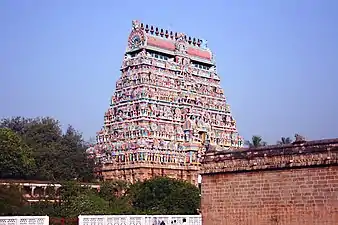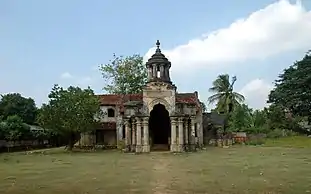Pandya dynasty
The Pandya dynasty, also known as the Pandyas of Madurai, was a dynasty of south India, one of the three famous Tamil lineages, the other two being the Chola and the Chera.[5] The dynasty passed through two periods of imperial dominance, between the 6th and 10th centuries CE, and under the 'Later Pandyas' (13th - 14th centuries CE). The Pandyas ruled extensive territories, at times including the large portions of present-day south India and Sri Lanka (through collateral branches subject to Madurai).[6][7]
Pandya Dynasty | |||||||||||||
|---|---|---|---|---|---|---|---|---|---|---|---|---|---|
 Pandya royal insignia (medieval) | |||||||||||||
.png.webp) Pandya Kingdom (12th–14th century CE) | |||||||||||||
| Capital | |||||||||||||
| Official languages | |||||||||||||
| Religion | Hinduism | ||||||||||||
| Government | Monarchy | ||||||||||||
• 560–590 CE | Kadungon | ||||||||||||
• 1100–1400 CE | "Five Pandyas" | ||||||||||||
| |||||||||||||
| Today part of | India Sri Lanka | ||||||||||||
| Part of a series on |
| Dravidian culture and history |
|---|
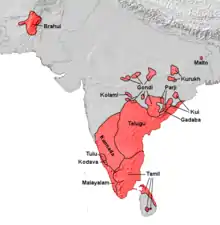 |
| Portal:Dravidian civilizations |
| Part of a series on |
| History of Tamil Nadu |
|---|
 |
The rulers of the three Tamil dynasties were referred to as "the three crowned rulers (the mu-ventar) of the Tamil country".[5][8] The age and antiquity of the Pandya dynasty is difficult to establish.[7] The early Pandya chieftains ruled their country (the Pandya nadu) from time immemorial, which included the inland city of Madurai and the southern port of Korkai.[9][10] The Pandyas are celebrated in the earliest available Tamil poetry ("the Sangam literature").[7] Graeco-Roman accounts (as early as 4th century BCE[7]), the edicts of Maurya emperor Asoka, coins with legends in Tamil-Brahmi script, and Tamil-Brahmi inscriptions suggest the continuity of the Pandya dynasty from the 3rd century BCE to early centuries CE.[11][12][9] The early historic Pandyas faded into obscurity upon the rise of the Kalabhra dynasty in south India.[13]
From 6th century to 9th century CE, the Chalukyas of Badami or Rashtrakutas of the Deccan, the Pallavas of Kanchi, and Pandyas of Madurai dominated the politics of south India. The Pandyas, at one time or another, ruled or invaded the fertile estuary of Kaveri (the Chola country), the ancient Chera country (Kongu and central Kerala) and Venadu (south Kerala), the Pallava country and Sri Lanka.[14] The Pandyas went into decline with the rise of the Cholas of Tanjore in the 9th century and were in constant conflict with them. The Pandyas allied themselves with the Sinhalese (Sri Lanka) and the Cheras in harassing the Chola Empire until they found an opportunity for reviving their fortunes during the late 13th century.[15]
The Pandyas entered their "golden age" under Maravarman I and Jatavarman Sundara Pandya I (13th century).[6][7] Some early efforts by Maravarman I to expand into the ancient Chola country were effectively checked by the Hoysalas.[16] Jatavarman I (c. 1251) successfully expanded the empire into the Telugu country (as far north as Nellore), south Kerala and conquered northern Sri Lanka.[6][7] The city of Kanchi became a secondary capital of the Pandyas. The Hoysalas, in general, were confined to Mysore Plateau and even king Somesvara was killed in a battle with Pandyas.[17] Maravarman Kulasekhara I (c. 1268) defeated an alliance of the Hoysalas and the Cholas (1279) and invaded Sri Lanka. The venerable Tooth Relic of the Buddha was carried away by the Pandyas. During this period the rule of the empire was shared among several royals, one of them enjoying primacy over the rest.[17] An internal crisis in the Pandya empire coincided with the Khalji invasion of south India in 1310–11.[7] The ensuing political crisis saw more sultanate raids and plunder, the loss of south Kerala (1312), and north Sri Lanka (1323) and the establishment of the Madurai sultanate (c. 1334[1]).[18][19] In the mid-16th century, the Vijayanagara governors of Madurai declared independence and established the Madurai Nayak dynasty.[7] The Pandyas of Ucchangi (9th–13th century), in the Tungabhadra Valley were related to the Pandyas of Madurai.[7]
According to tradition, the legendary Sangams ("the Academies") were held in Madurai under the patronage of the Pandyas, and some of the Pandya rulers claim to be poets themselves. The Pandya country was home to a number of renowned temples including Meenakshi Temple in Madurai. After the revival of the Pandya power by Kadungon (7th century AD), the Shaivite nayanars and the Vaishnavite alvars rose to prominence.[20] It is known that the Pandya rulers followed Jainism for a short period of time in history.[7]
Etymology and origin legends
The word pandya is thought to be derived from the ancient Tamil word "pandu" meaning "old".[21] The theory suggests that in early historic Tamil lexicon the word pandya means old country in contrast with Chola meaning new country, Chera meaning hill country and Pallava meaning branch in Sanskrit.[22] The etymology of pandya is still a matter of considerable speculation among scholars. Apart from the derivations mentioned, a number of other theories do appear in historical studies.[23]
According to the ancient Tamil legends, the three brothers Cheran, Cholan and Pandyan ruled in common at the southern city of Korkai. While Pandya remained at home, his two brothers Cheran and Cholan after a separation founded their own kingdoms in north and west.[24] Epic poem Silappatikaram mentions that the emblem of the Pandyas was that of a fish.[25] North Indian traditions such as the Great Epics and the Puranas often associate southern India with Sage Agastya (who crossed the Vindhyas and travelled south). Agastya appears prominently in medieval Tamil literature also.[26]
Folklores attributes Alli Rani (meaning "the queen Alli") as one of the early historic rulers of the Pandyas. She is attributed as an "amazonian queen" whose servants were men and administrative officials and army were women.[27] She is thought of ruling the whole western and northern coast of Sri Lanka from her capital Kudiramalai, where remains of what is thought of as her fort are found.[28] She is sometimes seen as an incarnation of the Pandya associated gods, Meenakshi and Kannagi.[29]
Chandra-vamsa
The medieval Pandya kings were claimed to have belonged to the Chandra-vamsa or the Lunar Race.[30] They claimed Pururavas and Nahusha as ancestors.[31] Pururavas is listed as one of the ancestors in the Velvikudi Inscription of Nedunjadaiyan Varaguna-varman I (Jatila Parantaka Nedunjadaiyan).[32] The Sinnamanur Plates of Maravarman Rajasimha III similarly traces his lineage to the Lunar race and also claims that one of his ancestors, a Pandya occupied the seat of god Indra and another ancestor forced the ten-headed king of Lanka (Ravana) to sue for peace.
Sources of Pandya history
Archaeological sources
Pandyas are also mentioned in the inscriptions of Maurya emperor Asoka (3rd century BCE). In his inscriptions (2nd and 13th Major Rock Edict[33]) Asoka refers to the peoples of south India – the Chodas, Keralaputras, Pandyas and Satiyaputras.[34][35] These polities, although not part of the Maurya empire, were on friendly terms with Asoka:
The conquest by dharma has been won here, on the borders, and even six hundred yojanas (5,400–9,600 km) away, where the Greek king Antiochos rules, beyond there where the four kings named Ptolemy, Antigonos, Magas and Alexander rule, likewise in the south among the Cholas, the Pandyas, and as far as Tamraparni river.[36]
.jpg.webp)
The earliest Pandya to be found in epigraph is Nedunjeliyan, figuring in the Tamil-Brahmi Mangulam inscription (near Madurai) assigned to 3rd and 2nd centuries BCE.[37] The record documents a gift of rock-cut beds, to a Jain ascetic. It is assumed that the people found in the Mangulam inscription, Nedunjeliyan, Kadalan, and Izhanchadikan predates rulers such as Talaiyanganam Nedunjelyan and Palyaga-salai Mudukudimi Peruvaludi.[38][33]
Kharavela, the Kalinga king who ruled during c. 1st century BCE, in his Hathigumpha inscription, claims to have destroyed an old confederacy of Tamil countries ("the tamira–desa–sanghata") which had lasted 132 years, and to have acquired a large quantity of pearls from the Pandyas.[35]
Silver punch-marked coins with the fish symbol of the Pandyas dating from around the same time have also been found.[39]
Early Tamil literature
The early historic Pandyas are celebrated in the earliest available Tamil poetry.[7] The poems refers to about twelve Pandya rulers.[11] According to tradition, the legendary Sangams ("the Academies") were held in Madurai under the patronage of the Pandyas. Several Tamil literary works, such as Iraiyanar Agapporul, mention the legend of three separate Sangams and ascribe their patronage to the Pandyas.[40]
Pandya rulers – such as Nedunjeliyan, the Victor of Talaiyalanganam, and Mudukudimi Peruvaludi, the Patron of Several Sacrificial Halls ("the Palyaga-salai") – find mention in a number of poems (such as Mathuraikkanci).[38][42]
Beside several short poems found in the Akananuru and the Purananuru collections, there are two major works – Mathuraikkanci and Netunalvatai – which give a glimpse into the society and commercial activities in the Pandya country during the early historic period.[43][44] The Purananuru and Agananuru collections contain poems sung in praise of various Pandya rulers and also poems that were claimed to be composed by the rulers themselves.[45]
Besides the poems, king Peruvaludi is also mentioned in later copper-plate grant (8th–9th century CE).[42] In the work Mathuraikkanci, the author Mankudi Maruthanar, refers to his patron, Talaihalanganum Nedunjeliyan, as the Lord of Korkai and the Warlord of the Southern Parathavar People.[42] It contains a full-length description of Madurai and the Pandya country under the rule of Nedunjeliyan. In the famous battle of Talaiyalanganam (in east Tanjore), the Pandya is said to have defeated his enemies (which included the Chera and the Chola).[42] He is also praised for his victory of Mizhalai and Mutturu, two "vel" centres along the ocean (in Pudukkottai).[42] The Netunalvatai (in the collection of Pattupattu) by Nakkirar contains a description of king Nedunjeliyan's palace.[45]
Foreign sources
| Outline of South Asian history |
|---|
_without_national_boundaries.svg.png.webp) |
Greek and Latin sources (early centuries CE) refer to the ancient Tamil country, same as the Tamilakam, as "Lymyrike" or "Damirice" (or Dymirice/Dimirixe or Damirice) and its ruling families.[11]
- Pandyas are also mentioned by Greek author Megasthenes (4th century BCE) where he writes about south Indian kingdom being ruled by women.[46] He described the Pandya country in Indika as "occupying the portion of India which lies southward and extends to the sea". According to his account, the kingdom had 365 villages, each of which was expected to meet the needs of the royal household for one day in the year. He described the Pandya queen at the time, Pandaia as the daughter of Herakles.[47][48]
- Pliny the Elder refers to the Pandya ruler of Madurai in general terms (first century CE).[11]
- The author of the Periplus of the Erythraean Sea (first century CE) describes the riches of a "Pandian kingdom"[11][12]
...Nelcynda is distant from Muziris by river and sea about five hundred stadia, and is of another kingdom, the Pandian. This place [Nelcynda] also is situated on a river, about one hundred and twenty stadia from the [Arabian] sea.... [49]
- The country of the Pandyas was described as Pandya Mediterranea and Modura Regia Pandionis by Ptolemy (c. 140 CE[11]).[50]
- Strabo states that an Indian king called Pandion sent Augustus Caesar "presents and gifts of honour".[51][10] The 1st-century Greek historian Nicolaus of Damascus met, at Antioch, the ambassador sent by a king from India "named Pandion or, according to others, Porus" to Caesar Augustus around 13 CE (Strabo XV.4 and 73).[52][53]
- The Roman emperor Julian received an embassy from a Pandya about 361 CE.[7]
- Chinese historian Yu Huan in his 3rd-century CE text, the Weilüe, mentions the Panyue kingdom:
...the kingdom of Panyue is also called Hanyuewang. It is several thousand li to the southeast of Tianzhu (northern India)...The inhabitants are small; they are the same height as the Chinese...
Scholar John E. Hill identified Panyue as Pandya kingdom.[54] However, others have identified it with an ancient state located in modern Burma[55] or Assam.[56]
- The Chinese traveler Xuanzang mentions a kingdom further south from Kanchipuram, a kingdom named Malakutta, identified with Madurai described by his Buddhist friends at Kanchipuram.[57]
- In the later part of the 13th century (in 1288 and 1293 CE) Venetian traveller Marco Polo visited the Pandya kingdom and left a vivid description of the land and its people.[58][59]
The darkest man is here the most highly esteemed and [60] better than the others who are not so dark. Let me add that in very truth these people portray and depict their gods and their idols black and their devils white as snow. For they say that god and all the saints are black and the devils are all white. That is why they portray them as I have described.[61]
Early historic Pandyas

Maurya emperor Asoka (3rd century BCE) seems to have been on friendly terms with the people of south India and Sri Lanka (the Cholas, the Pandyas, the Satiya Putras, the Kerala Putras and the Tamraparnis). There are no indications that Asoka tried to conquer the extreme south India (the Tamilakam – the Abode of the Tamils).[62]
The three chiefly lines of the early historic south India – the Cheras, Pandyas and Cholas – were known as the mu-vendar ("the three vendars"). They traditionally based at their original headquarters in the interior Tamil Nadu (Karur, Madurai and Uraiyur respectively).[10] The powerful chiefdoms of the three ventar dominated the political and economic life of early historic south India.[63] The frequent conflicts between the Chera, the Chola and the Pandya are well documented in ancient (the Sangam) Tamil poetry.[64] The Cheras, Cholas and Pandyas also controlled the ports of Muziris (Muchiri), Korkai and Kaveri respectively (for the trade with the Graeco-Roman world).[10] The gradual shift from chiefdoms to kingdoms seems to have occurred in the following period.[63]
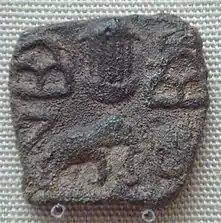
The famous inscription of king Kharavela at Hathigumpha (mid-first century BCE[10]) mentions the defeat of a confederacy of the "Tramira" countries which had been a threat to Kalinga. It also remembers the precious pearls brought to the capital as booty from the "Pandya" realm.[65] The Pandya chiefdom was famous for its pearl fisheries and silk industry.[10] Korkai and Alagankulam are believed to have been the exchange centres of the Pandyas. Korkai, a port at the mouth of the river Tambraparni, was linked to the famous pearl fisheries and Alagankulam was also developed as a port.[66]
A number of coins attributed to early historic Pandyas are found from the region.[64] Inscriptions, datable to c. 2nd century BCE, recording royal grants – both from royals and wealthy commoners – were also discovered from the Pandya country.[67]
The Pandya seems to be the most prominent of the three "ventar" rulers. There are even references to a Pandya queen from 3rd century BCE representing a confederacy of the Tamil countries.[10] Madurai, in south Tamil Nadu, was the most important cultural centre in south India as the core of the Tamil speakers.[67] Megalithic relics such as menhirs, dolmens, urn burials, stone circles and rock-cut chambers/passages can be found in south India. Burial goods include iron objects, ivory ornaments, Black-and-Red Ware and even some Roman Imperial coins.[68] The so-called "velir" hill chieftains are assumed to be associated with these megalithic burials.[63]
Greek and Latin accounts (early centuries CE), coins with legends in Tamil-Brahmi script, and Tamil-Brahmi inscriptions suggest the continuity of the Pandya dynasty from the 3rd century BCE to early centuries CE.[11] The early Pandyas, along with the Cheras and the Cholas, were eventually displaced by the Kalabhra dynasty.[13]
Medieval Pandyas
Pandya revival (7th–10th centuries CE)
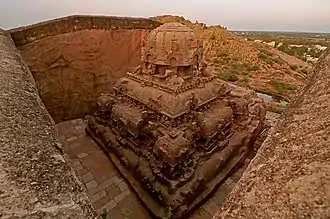
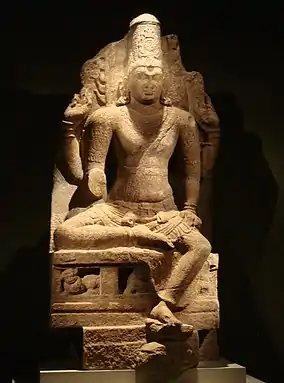
.jpg.webp)
The Pandya kingdom was revived by king Kadungon (r. 590–620 CE[14]) towards the end of the 6th century CE.[7][69] In the Velvikudi inscription, a later copper-plate, Kadungon appears as the "destroyer" of the "anti-Brahmanical" Kalabhra kings.[14] With the decline of the Kalabhra dynasty, the Pandyas grew steadily in power and territory. With the Cholas in obscurity in Uraiyur, the Tamil country was divided between the Pallavas of Kanchi and the Pandyas of Madurai.[70]
From 6th century to 9th century CE, the Chalukyas of Badami, the Pallavas of Kanchi, and Pandyas of Madurai dominated the politics of south India. The Badami Chalukyas were eventually replaced by the Rashtrakutas in the Deccan.[71] The Pandyas took on the growing Pallava ambitions in south India, and from time to time they also joined in alliances with the kingdoms of the Deccan Plateau (such as with the Gangas of Talakad in late 8th century CE).[67] In the middle of the 9th century, the Pandyas had managed to advance as far as Kumbakonam (north-east of Tanjore on the Kollidam river).[67]
Sendan (r. 654–70 CE), the third king of the Pandyas of Madurai, is known for expanding his kingdom to the Chera country (western Tamil Nadu and central Kerala). Arikesari Maravarman (r. 670–700 CE), the fourth Pandya ruler, is known for his battles against the Pallavas of Kanchi. Pallava king Narasimhavarman I (r. 630–68 CE), the famous conqurer of Badami, claimed to have defeated the Pandyas. Chalukya king Paramesvaravarman I "Vikramaditya" (r. 670–700 CE) is known to have fought battles with the Pallavas, the Gangas, and probably with the Pandyas too, on the Kaveri basin.[14]
Kirtivarman II (r. 744/5–55 CE), the last Chalukya king, managed to lose to his southern countries as a result of his battles with the Pandyas. Pandya kings Maravarman Rajasimha I (r. 730–65 CE) and Nedunjadaiyan/Varagunavarman I (r. 765–815 CE) threatened Pallava king Nandivarman II Pallavamalla (r. 731–96 CE) who had managed to defeat the Gangas in around 760 CE. Varagunavarman I invaded the Pallava country, conquered the Kongu country (western Tamil Nadu) and Venadu (south Kerala). King Srimara Srivallabha (r. 815–62 CE) sailed to Sri Lanka, subjugated king Sena I, and sacked his capital Anuradhapura (the Panya invasion of Sri Lanka followed a period of vassalage).[14] However, Srimara Srivallabha was soon overpowerd by Pallava king Nripatunga (r. 859–99 CE). Sena II, the king of Sri Lanka, invaded the Pandya country, sacked Madurai and chose Varagunavarman II (r. c. 862–880 CE[72]) as the new king soon after.[14] It is proposed that the start of the Kollam Era, the Kerala calendar, in 825 CE marked the liberation of Venadu from Pandya control.[73]
During the rule of Dantivarman (r. 796–847 CE), the Pallava territory was reduced by the encroachment from the Pandyas from the south (and Rashtrakutas and the Telugu-Chodas from north). Pallava king Nandivarman III (r. 846–69 CE) was able to defeat the Pandyas and Telugu-Chodas (and even the Rashtrakutas) with the help of the Gangas and the emerging Cholas.[14]
| Pandya ruler | Reign | Ref. |
|---|---|---|
| Kadungon | c. 590–620 CE | [14][72] |
| Maravarman Avanisulamani | c. 620–645 CE | [72] |
| Cheliyan Sendan (Chendan) | c. 654–670 CE | [14][72] |
| Arikesari Maravarman (Parankusan) | c. 670–700 CE | [14][72] |
| Ko Chadaiyan Ranadhira | c. 700–730 CE | [72] |
| Maravarman Rajasimha I | c. 730–765 CE | [14][72] |
| Jatila Parantaka Nedunjadaiyan
(Varaguna-varman I) |
c. 765–815 CE | [14][72] |
| Maravarman Srimara Srivallabha | c. 815–862 CE | [14] |
| Varaguna-varman II | c. 862–880 CE | [74] |
| Parantaka Viranarayana | c. 880–900/905 CE | [72] |
| Maravarman Rajasimha III | c. 900–920 CE | [72] |

Under Chola influence (10th–13th centuries)
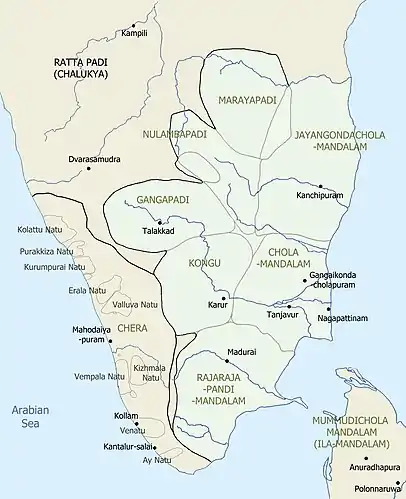
While the Pandyas and the Rashtrakutas were busy engaging the Pallavas, with the Gangas and the Simhalas (Sri Lanka) also in the mix, the Cholas emerged from the Kaveri delta and took on the chieftains of Thanjavur[75] (the Mutharaiyar chieftain had transferred their loyalty from the Pallava to the Pandya[76]). The Chola king Vijayalaya conquered Thanjavur by defeating the Mutharaiyar chieftain around c. 850 CE.[76] The Pandya control north of the Kaveri river was severely weakened by this move (and straightened the position of the Pallava ruler Nripatunga).[76] Pandya ruler Varaguna-varman II (r. c. 862–880 CE[72]) responded by marching into the Chola country and facing a formidable alliance of Pallava prince Aparajita, the Chola king Aditya I and the Ganga king Prithvipati I. The Pandya king suffered a crushing defeat (c. 880 CE) in a battle fought near Kumbakonam.[76]
By c. 897 CE, Chola king Aditya I was the master of the old Pallava, Ganga and Kongu countries. It is a possibility that Aditya I conquered the Kongu country from the Pandya king Parantaka Viranarayana (r. 880–900 CE).[76] Parantaka I, successor to Aditya, invaded the Pandya territories in 910 CE and captured Madurai from king Maravarman Rajasimha II (hence the title "Madurai Konda").[76] Rajasimha II received help from the Sri Lankan king Kassapa V, still got defeated by Parantaka I in the battle of Vellur, and fled to Sri Lanka. Rajasimha then found refuge in the Chera country, leaving even his royal insignia in Sri Lanka, the home of his mother.[76][77]
The Cholas were defeated by a Rashtrakuta-lead confederacy in the battle of Takkolam in 949 CE.[15] By mid-950s, the Chola kingdom had shrunk to the size of a small principality (its vassals in the extreme south had proclaimed their independence).[15] It is a possibility that Pandya ruler Vira Pandya defeated Chola king Gandaraditya and claimed independence.[15] Chola ruler Sundara Parantaka II (r. 957–73) responded by defeating Vira Pandya in two battles (and Chola prince Aditya II killed Vira Pandya on the second occasion). The Pandyas were assisted by Sri Lanka forces of king Mahinda IV.[15]
Chola emperor Rajaraja I (r. 985–1014 CE) is known to have attacked the Pandyas.[67] He fought against an alliance of the Pandya, Chera and Sri Lankan kings, and defeated the Cheras and "deprived" the Pandyas of their ancient capital Madurai.[78] Emperor Rajendra I continued to occupy the Pandya kingdom, and even appointed a series of Chola viceroys with the title "Chola Pandya" to rule from Madurai (over Pandya and Western Chera/Kerala countries). The very of beginning of Chola emperor Kulottunga's rule (r. from 1070 CE) was marked by the loss of Sri Lanka and a rebellion in the Pandya country.[78]
The second half of the 12th century witnessed a major internal crisis in the Pandya country (between princes Parakrama Pandya and Kulasekhara Pandya). The neighbouring kingdoms of Sri Lanka, under Parakramabahu I, Venadu Chera/Kerala, under the Kulasekharas,[78] and the Cholas, under Rajadhiraja II and Kulottunga III, joinined in and took sides with any of the two princes or their kins.[79][78]
Pandya empire (13th–14th centuries)
The Pandya empire included extensive territories, at times including large portions of south India and Sri Lanka. The rule of the empire was shared among several royals, one of them enjoying primacy over the rest. The Pandya king at Madurai thus controlled these vast regions through the collateral family branches subject to Madurai.[7][81]

| Pandya ruler | Reign |
|---|---|
| Maravarman Sundara I | 1216–1238 CE |
| Sundaravarman Kulasekara II | 1238–1240 CE |
| Maravarman Sundara II | 1238–1251 CE |
| Jatavarman Sundara I | 1251–1268 CE |
| Maravarman Kulasekara I | 1268–1310 CE |
| Sundara Pandya IV | 1309–1327 CE |
| Vira Pandya IV | 1309–1345 CE |
Maravarman Sundara I
The foundation for the Pandya supremacy in south India was laid by Maravarman Sundara I early in the 13th century.[82] He succeeded his older brother Jatavarman Kulasekhara in 1216.[83] He invaded the Chola country, sacked Uraiyur and Thanjavur, and drove the Chola king Kulothunga III into exile.[83][84] The Chola king subsequently made a formal submission to Maravarman Sundara I and acknowledged his overlordship.[83] Attempts by the next Chola king Rajaraja III (1216 – 46 CE[6]) for self-rule (to stop the Pandya invasion into the Chola country[6]), with the help of the Hoysalas king Narasimha II (r. 1220 – 1238 CE), resulted in a battle between the Pandya and Hoysala forces at Mahendramangalam on the Kaveri Valley. Maravarman Sundara I was defeated and Rajaraja III was restored in the Chola country.[83] Sometime later Chola prince Rajendra III attacked the Pandyas and defeated two Pandya royals including Maravarman Sundara II.[83] Hoysala king Somesvara (r. 1233 – 1267 CE[6]) then came to the aid of the Pandyas, defeated Rajendra III and then made peace with the Cholas.[83][84]
Jatavarman Sundara I
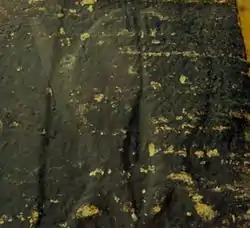
Jatavarman Sundara I ascended the Pandya throne in 1251 CE.[6] He led his army to the Chola country (even as far as Nellore), to Sri Lanka and to south Kerala.[6] He was also successful in confining the Hoysala control to the Mysore Plateau (the ancient Chola country was now overrun by the Pandyas[6]).[83] Kanchi functioned as the second major city in the kingdom.[83] In his conquests, Jatavarman Sundara I was assisted by number of Pandya royals such as Jatavarman Vira Pandya.[83]
Jatavarman Sundara I subdued Rajendra II around 1258–1260 CE and made him pay tribute.[84] The rule of the Cholas ended c. 1279 with Rajendra III.[6] The Pandya attacked the Hoysalas in the Kaveri and captured the fort of Kannanur Koppam.[83] Hoysala king Somesvara was forced to fall back into the Mysore Plateau.[83] The Hoysala king, pressed by enemies from north and south, "assigned" the southern half of his kingdom to his younger son Ramanatha (r. 1254–1292[6]). Somesvara was eventually killed by the Pandya in 1262 CE.[83] Ramanatha managed to recover Kannanur and hold against the Pandya power.[81][86][87] Jatavarman Sundara I also came into conflict with the Kadava ruler Kopperunjinga II.[88][83] It seems that Bana (Magadai) and Kongu countries came under the Pandya rule during the wars against the Hoysalas and the Kadavas.[83] Jatavarman Sundara I also fought the Kakatiya ruler Ganapati (1199-1262[6]).[81] Sri Lanka was invaded by Jatavarman Sundara I in 1258[89] and on his behalf by his younger brother Jatavarman Vira II between 1262 and 1264 CE.[90] The island was again invaded and defeated by Jatavarman Vira II in 1270 CE.[91]
Maravarman Kulasekara I
Sundara Pandya I (died in 1268) was succeeded by Maravarman Kulasekara I.[81] Around 1279 the combined force of Hoysala king Ramanatha and Rajendra III was defeated by Maravarman Kulasekara I.[81] Maravarman Kulasekara I, now virtually unchallenged, ruled over the Chola country and southern Tamil speaking portions of Hoysala kingdom. He also invaded Sri Lanka, ruled by Bhuvanaikabahu I, "carried away to the Pandya country the venerable Tooth Relic", and the wealth of the island.[81] Sri Lanka remained under Pandya control till c. 1308-09 CE.[81]
Decline of Pandyas
After the death of Maravarman Kulasekhara I (1310), his sons Vira Pandya IV and Sundara Pandya IV fought a war of succession for control of the empire. It seems that Maravarman Kulasekhara wanted Vira Pandya to succeed him (who inturn was defeated by Sundara Pandya after a short period of time).[92] Unfortunately, the Pandya civil war coincided with the Khalji raids in south India.[93] Taking advantage of the political situation, the neighbouring Hoysala king Ballala III invaded the Pandya territory. However, Ballala had to retreat to his capital, when Khalji general Malik Kafur invaded his kingdom at the same time.[94] After subjugating Ballala III, the Khalji forces marched to the Pandya territory in March 1311.[95] The Pandya brothers fled their headquarters, and the Khaljis pursued them unsuccessfully.[96][97] By late April 1311, the Khaljis gave up their plans to pursue the Pandya princes, and returned to Delhi with the plunder.[98][99] By 1312 the Pandya control over south Kerala was also lost.[7]
After departure of the Khaljis, Vira and Sundara Pandya resumed their conflict. Sundara Pandya was defeated, and sought help from the Khaljis. With their help, he regained control of the South Arcot region by 1314.[99] Subsequently, there were two more expeditions from the sultanate in 1314 led by Khusro Khan and in 1323 by Ulugh Khan (Muhammad bin Tughluq) under sultan Ghiyath al-Din Tughluq.[99]
The family quarrels and the sultanate invasions shattered the Pandya empire beyond revival[7] and coinage discoveries made imply that the Pandyas were left with the old South Arcot region.[100] In 1323, the Jaffna kingdom declared its independence from the crumbling Pandya influence.[18][19]
Legacy
While the previous sultanate raids were content with plunder, the Tughluqs under Ulugh Khan (later Muhammad bin Tughluq[1]) annexed the former Pandya dominions to the sultanate as the province of Ma'bar. Most of south India came under the sultanate rule and was divided into five provinces – Devagiri, Tiling, Kampili, Dorasamudra and Ma'bar.[100] Jalal ud-Din Hasan Khan was appointed governor of the newly created southernmost Ma'bar province.[101][102] In c. 1334, Jalal ud-Din Hasan Khan declared his independence and created Madurai sultanate.[1] The Pandyas shifted their capital to Tenkasi and continued to rule a small area until the end of the 16th century.[1]
Bukka Raya I of Vijayanagara empire conquered the city of Madurai in c. 1370,[1] imprisoned the sultan, released and restored Arcot's prince Sambuva Raya to the throne. Bukka Raya I appointed his son Veera Kumara Kampana as the viceroy of the Tamil region. Meanwhile, Madurai sultanate was replaced by the Nayak governors of Vijayanagara in 1378.[103] In 1529 the Nayak governors declared independence and established Madurai Nayak dynasty.[7]
Economy
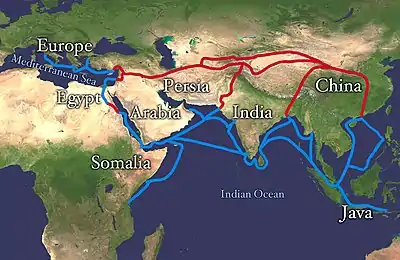
Early historic
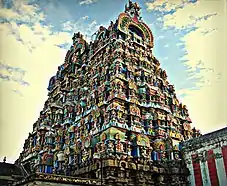
The Pandya country, located at the extreme south-western tip of South Asia, served as an important meeting point throughout the history of the India. The location was economically and geopolitically significant as a key point connecting the shipping between Southeast Asia and the Middle East. Graeco-Roman merchants frequented the ancient Tamil country, present day south India and Sri Lanka, securing contacts with the Tamil chiefdoms of the Pandya, Chola and Chera families.[9] The western sailors also established a number of trading settlements on the harbours of the ancient Tamil region.[9]

The trade with South Asia by the Greco-Roman world flourished since the time of the Ptolemaic dynasty[104] a few decades before the start of the Common Era and remained long after the fall of the Western Roman Empire.[105][106] The contacts between south India and the Middle East continued even after the Byzantium's loss of the ports of Egypt and the Red Sea[107] in the 7th century CE.
The early historic Pandya country was famous for its supply of pearls. The ancient port of Korkai, in present-day Thoothukudi, was the center of pearl trade. Written records from Graeco-Roman and Egyptian voyagers give details about the pearl fisheries off the Gulf of Mannar. Greek historian Megasthenes reported about the pearl fisheries, indicating that the Pandyas derived great wealth from the pearl trade.[108] Convicts were according to the Periplus of the Erythraean Sea used as pearl divers in Korkai.[109] The Periplus even mentions that "pearls inferior to the Indian sort are exported in great quantity from the marts of Apologas and Omana".[110] The pearls from the Pandya country were also in demand in the kingdoms of north India.[111] Literary references of the pearl fishing mention how the fishermen, who dive into the sea, avoid attacks from sharks, bring up the right-whorled chank and blow on the sounding shell.[112]
Pandya coinage
The early coins of Tamilakam bore the symbols of the Three Crowned Kings, the tiger, the fish and the bow, representing the symbols of the Cholas, Pandyas and Cheras.[113] Coins of Pandyas bear the legend of different Pandya ruler in different times. The Pandyas had issued silver punch-marked and die struck copper coins in the early period.[114] A few gold coins were attributed to the Pandya rulers of this period. These coins bore the image of fish, singly or in pairs, which were their emblem.[115]
Some of the coins had the names Sundara, Sundara Pandya or merely the letter 'Su' were etched. Some of the coins bore a boar with the legend of 'Vira-Pandya.[116] It had been said that those coins were issued by the Pandyas and the feudatories of the Cholas but could not be attributed to any particular king. The coins of Pandyas were basically square. Those coins were etched with elephant on one side and the other side remained blank. The inscription on the silver and gold coins during the Pandyas, were in Tamil-Brahmi and the copper coins bore the Tamil legends.[117] The coins of the Pandyas, which bore the fish symbols, were termed as 'Kodandaraman' and 'Kanchi' Valangum Perumal'.[118] Apart from these, 'Ellamthalaiyanam' was seen on coins which had the standing king on one side and the fish on the other. 'Samarakolahalam' and 'Bhuvanekaviram' were found on the cois having a Garuda, 'Konerirayan' on coins having a bull and 'Kaliyugaraman' on coins that depict a pair of feet.[119]
Religion
_witnessed_by_Vishnu%252C_Meenakshi_Temple%252C_Madurai_(2)_(36857653813).jpg.webp)
The Pandya period (c. 13th century CE) was characterised by a temple-centered elite form of Hinduism, a popular bhakti religion and an even more widespread local forms of Hinduism. The distinctions between the three were not clearly differentiated. The worship of the gods Vishnu and Shiva was generally supported by the elite.[120] The bhakti movement emphasized the mutual intense emotional attachment between the god and the devotee.[121]
The Pandya country was home to a number of renowned temples including Meenakshi Temple in Madurai.[122] As some of the largest employers and landowners of the Pandya country, the temples played an important part in the Tamil economy and society.[123] They generally also served as banks, schools, dispensaries, and poorhouses (thus performing valuable social functions). The large walled temple complexes of the Pandya country also contained several administrative offices and bazaars.[123]
It is known that the Pandya rulers followed Jainism for a short period of time in history.[124]
Architecture

The early temple architecture phase in Tamil Nadu opens with the rock-cut cave temples.[125][126]
The Tamil country is home to the 'South Indian' or 'Dravidian' style of medieval temple architecture.[125]
- Typical temple consists of a hall and a square sanctum (the gabhagrha)
- The foundation block, or socle, is known as the adhisthana.
- Walls of the sanctum are generally divided by pilasters.
- Superstructure - 'kutina' type (stepped stories in pyramidal form with decorative bands/parapets or the hdras)
- The parapet is composed of miniature shrines (called the kutas and salas) connected by wall elements (the harantaras).
- On top - a necking that supports a solid dome, or cupola (crowned by a pot and finial) - the sikhara.
- Gopura - the great entrance buildings[127]
The major Pandya contributions to the Dravidian architecture comes after the Pallava (7th-9th centuries) and the Chola periods (9th-12th centuries).[125]
- Gopuras are extremely large and elaborately decorated (capped by a barrel vault).[125]
- Successively built walls and gopuras.[125]
Finest Pandya architecture
See also
References
- Karashima, Noburu. 2014. 'The Fall of the Old States', in A Concise History of South India: Issues and Interpretations, ed. Noburu Karashima, pp. 173–74. New Delhi: Oxford University Press.
- "Classical Indo-Roman Trade". Economic and Political Weekly. 48 (26–27). 5 June 2015.
- Upinder Singh (2008). A History of Ancient and Early Medieval India: From the Stone Age to the 12th Century. Pearson Education India. p. 46. ISBN 978-81-317-1120-0.
Kings of the Chola and Pandya dynasties also issued Tamil and bilingual Sanskrit–Tamil inscriptions.
- C. Sivaramamurti (1977). L'Art en Inde. H. N. Abrams. p. 60. ISBN 978-0-8109-0630-3.
Thus the state language was Sanskrit whether the inscriptions were from the north or the south and whether the dynasty was Gupta, Vakatak[a], Vardhana, Maukhari, Pratihara, Paramara, Chandella, Pala, Sena, Gahadavala, Haihaya, Ganga, Pallava, Chola, Pandya, Chalukya, Rashtrakuta, or Vijayanagar[a]. Inscriptions were sometimes written in regional languages, but they invariably had a preface in Sanskrit.
- Subbarayalu, Y. 2014. 'Early Tamil Polity', in A Concise History of South India: Issues and Interpretations, ed. Noburu Karashmia, pp. 53–54. New Delhi: Oxford University Press.
- Karashima, Noburu. 2014. 'The Fall of the Old States', in A Concise History of South India: Issues and Interpretations, ed. Noburu Karashima, pp. 172–73. New Delhi: Oxford University Press.
- "Pandya dynasty | Indian dynasty". Encyclopedia Britannica. Retrieved 21 September 2017.
- Inc, Encyclopaedia Britannica (1 March 2009). Britannica Guide to India. Encyclopaedia Britannica, Inc. p. 57. ISBN 978-1-59339-847-7.
- "Classical Indo-Roman Trade". Economic and Political Weekly. 48 (26–27). 5 June 2015.
- "Classical Indo-Roman Trade". Economic and Political Weekly. 48 (26–27): 7–8. 5 June 2015.
- Subbarayalu, Y. 2014. 'Early Tamil Polity', in A Concise History of South India: Issues and Interpretations, ed. Noburu Karashmia, pp. 47–48. New Delhi: Oxford University Press.
- Vincent, William (1805). The Periplus of the Erythrean Sea. Cadell and Davies. p. 403.
- Romila Thapar 2003, p. 327.
- Noboru Karashima 2014, p. 85-87.
- Sastri, K. A. Nilakanta. (1958, second ed.) A History of South India from Prehistoric Times to the Fall of Vijayanagar. Madras, Oxford University Press. 170-72.
- Sastri, K. A. Nilakanta. "The Age of the Four Kingdoms". A History of South India: From Prehistoric Times to the Fall of Vijayanagar (1958 ed.). Oxford University Press. pp. 203–05.
- Sastri, K. A. Nilakanta. "The Age of the Four Kingdoms". A History of South India: From Prehistoric Times to the Fall of Vijayanagar (1958 ed.). Oxford University Press. pp. 207–08.
- Sri Lanka and South-East Asia: Political, Religious and Cultural Relations from A.D. c. 1000 to c. 1500, 1978 By W. M. Sirisena, 57 p.
- Politics of Tamil Nationalism in Sri Lanka, South Asian Publishers, 1996 by Ambalavanar Sivarajah, 22 p.
- A. Soundaram (2011). "The Characteristic Features of Early Medieval Tamil Society". In S. Ganeshram; C. Bhavani (eds.). History of People and Their Environs. Bharathi Puthakalayam. pp. 68–69. ISBN 978-93-80325-91-0.
- Avari, Burjor (1 July 2016). India: The Ancient Past: A History of the Indian Subcontinent from c. 7000 BCE to CE 1200. Routledge. p. 249. ISBN 9781317236733.
- Madras, University of (1973). Journal: Humanities.
- Oppert, Gustav saloman (1888). On the Original Inhabitants of Bharatavarsa or India. p. 104. ISBN 9925082196.
- Caldwell, Bishop R. (1989). History of Tinnevelly. Asian Educational Services. p. 12. ISBN 9788120601611.
- Nākacāmi, Irāmaccantiran̲ (1978). Studies in Ancient Tamil Law and Society. Institute of Epigraphy, State Department of Archaeology, Government of Tamilnadu. p. 52.
- Karashima, Noburu. 2014. 'Beginnings of South Indian History', in A Concise History of South India: Issues and Interpretations, ed. Noburu Karashmia, pp. 25–26. New Delhi: Oxford University Press.
- University, Vijaya Ramaswamy, Jawaharlal Nehru (25 August 2017). Historical Dictionary of the Tamils. Rowman & Littlefield. p. 50. ISBN 9781538106860.
- Raghavan, M. D. (1971). Tamil culture in Ceylon: a general introduction. Kalai Nilayam. pp. 59–60.
- Shulman, David Dean (14 July 2014). Tamil Temple Myths: Sacrifice and Divine Marriage in the South Indian Saiva Tradition. Princeton University Press. p. 124. ISBN 9781400856923.
- James Henry Nelson. The Madura Country: A Manual. Asian Educational Services, 1989. p. 44.
- Irā Nākacāmi, Irāmaccantiran̲ Nākacāmi. Art and Culture of Tamil Nadu. Sundeep Prakashan, 1980. p. 2.
- H. K. Sastri (1983). "Velvikudi Grant of Nedunjadaiyan". Epigraphia Indica. 17. Archaeological Survey of India. p. 305.
- Karashima, Noburu. 2014. 'Beginnings of South Indian History', in A Concise History of South India: Issues and Interpretations, ed. Noburu Karashmia, pp. 26–27. New Delhi: Oxford University Press.
- Kulke and Rothermund, p104
- Keay, p119
- S. Dhammika, The Edicts of King Ashoka: An English Rendering Buddhist Publication Society, Kandy (1994) ISBN 955-24-0104-6
- Umamaheshwari, R. (25 January 2018). Reading History with the Tamil Jainas: A Study on Identity, Memory and Marginalisation. Springer. ISBN 978-81-322-3756-3.
- Subbarayalu, Y. 2014. 'Early Tamil Polity', in A Concise History of South India: Issues and Interpretations, ed. Noburu Karashmia, pp. 48–49. New Delhi: Oxford University Press.
- Champakalakshmi, Radha (1996). Trade, ideology, and urbanization: South India 300 BC to AD 1300. Oxford University Press. p. 123.
- Husaini, Abdul Qadir. The History of the Pandya Country. p. 5.
- Sastri, Kallidaikurichi Aiyah Nilakanta (1976). A history of South India from prehistoric times to the fall of Vijayanagar. Oxford University Press. pp. 22–25.
- Subbarayalu, Y. 2014. 'Early Tamil Polity', in A Concise History of South India: Issues and Interpretations, ed. Noburu Karashmia, pp. 52–53. New Delhi: Oxford University Press.
- Venkataramaiah, K. M.; Linguistics, International School of Dravidian (1996). A handbook of Tamil Nadu. International School of Dravidian Linguistics. p. 548. ISBN 9788185692203.
- Karuṇāniti, Kalaiñar Mu; Araṅkacāmi, Pal̲ani; Kal̲akam, Tañcai Tamil̲p Palkalaik (1997). Gleanings from Sangam verses: English version of Sangat Thamizh. Tamil University. p. 245.
- Roy, Kaushik (3 June 2015). Warfare in Pre-British India – 1500BCE to 1740CE. Routledge. p. 55. ISBN 9781317586920.
- Caldwell, Bishop R. (2004). History of Tinnevelly. Asian Educational Services. p. 16. ISBN 9788120601611.
- India By John Keay
- Caldwell, Bishop R. (2004). History of Tinnevelly. Asian Educational Services. p. 15. ISBN 9788120601611.
- Periplus 54. Original Greek: "Ἡ δὲ Νέλκυνδα σταδίους μὲν ἀπὸ Μουζιρέως ἀπέχει σχεδὸν πεντακοσίους, ὁμοίως διά τε ποταμοῦ (καὶ πεζῇ) καὶ διὰ θαλάσσης, βασιλείας δέ ἐστιν ἑτέρας, τῆς Πανδίονος· κεῖται δὲ καὶ αὐτὴ παρὰ ποταμὸν, ὡσεὶ ἀπὸ σταδίων ἑκατὸν εἴκοσι τῆς θαλάσσης."
- Balfur, Edward (1968). The Cyclopaedia of India and of Eastern and Southern Asia. Akademische Druck- u. Verlagsanstalt. p. 105.
- The First Spring: The Golden Age of India – Abraham Eraly – Google Books. Books.google.co.in. Retrieved on 12 July 2013.
- Strabo, Geography, BOOK XV., CHAPTER I., section 73. Perseus.tufts.edu. Retrieved on 12 July 2013.
- Keay, p121
- Hill, John
- Bin Yang (2009). Between winds and clouds: the making of Yunnan (second century BCE to twentieth century CE). Columbia University Press. ISBN 978-0-231-14254-0.
- Yukteshwar Kumar (2005). A History of Sino-Indian Relations. APH Publishing. p. 12. ISBN 978-81-7648-798-6.
- Smith, Vincent A. (1999). The Early History of India. Atlantic Publishers & Dist. p. 453. ISBN 9788171566181.
- Travel and ethnology in the Renaissance: South India through European eyes, Joan-Pau Rubiés
- Muslim identity, print culture, and the Dravidian factor in Tamil Nadu, J. B. Prashant More
- considered
- Layers of blackness: colourism in the African diaspora, Deborah Gabriel
- Romila Thapar 2003, p. 184.
- Romila Thapar 2003, p. 231.
- Romila Thapar 2003, p. 242.
- Romila Thapar 2003, p. 211-212.
- Romila Thapar 2003, p. 229.
- Thapar, Romila. Southern Indian kingdoms "India". Encyclopædia Britannica Online. https://www.britannica.com/place/India/The-Shunga-kingdom#ref46870
- Romila Thapar 2003, p. 230.
- Romila Thapar 2003, p. 331.
- "Pandya Dynasty | List of Pandya Rulers and their contributions". Jagranjosh.com. 8 December 2017. Retrieved 4 February 2021.
- Noboru Karashima 2014, p. 84-85.
- Sastri, K. A. Nilakanta. (1958, second ed.) A History of South India from Prehistoric Times to the Fall of Vijayanagar. Madras, Oxford University Press. 165.
- Noboru Karashima 2014, p. 89.
- Sastri, K. A. Nilakanta. (1958, second ed.) A History of South India from Prehistoric Times to the Fall of Vijayanagar. Madras, Oxford University Press. 165.
- Noboru Karashima 2014, p. 121-123.
- Sastri, K. A. Nilakanta. (1958, second ed.) A History of South India from Prehistoric Times to the Fall of Vijayanagar. Madras, Oxford University Press. 167–68.
- Wijetunga Mudalige Karunaratna Wijetunga. Sri Lanka and the Choḷas. Sarvodaya Vishva Lekha Publishers, 2003. p. 82.
- Noboru Karashima 2014, p. 122-124.
- Sastri, K. A. Nilakanta. (1958, second ed.) A History of South India from Prehistoric Times to the Fall of Vijayanagar. Madras, Oxford University Press. 187-90.
- Sen, Sailendra (2013). A Textbook of Medieval Indian History. Primus Books. pp. 45–46. ISBN 978-9-38060-734-4.
- Sastri, K. A. Nilakanta. (1958, second ed.) A History of South India from Prehistoric Times to the Fall of Vijayanagar. Madras, Oxford University Press. 208-11.
- Sen, Sailendra Nath (1999). Ancient Indian History and Civilization. New Age International. p. 458. ISBN 9788122411980.
- Sastri, K. A. Nilakanta. (1958, second ed.) A History of South India from Prehistoric Times to the Fall of Vijayanagar. Madras, Oxford University Press. 203-07.
- Majumdar, Ramesh Chandra (1977). Ancient India. Motilal Banarsidass. p. 411. ISBN 9788120804364.
- Indrapala, Karthigesu (2007). The evolution of an ethnic identity: The Tamils in Sri Lanka C. 300 BCE to C. 1200 CE. Colombo: Vijitha Yapa. p. 324. ISBN 978-955-1266-72-1.
- Sen, Sailendra Nath (1999). Ancient Indian History and Civilization. New Age International. p. 439. ISBN 9788122411980.
- Congress, Indian History (1957). Proceedings – Indian History Congress. p. 186.
- Majumdar, Ramesh Chandra; Bhavan, Bharatiya Vidya (1966). The History and Culture of the Indian People: The struggle for empire. Bharatiya Vidya Bhavan. pp. 257.
jatavarman kadava.
- Intirapālā, Kārttikēcu (1971). The collapse of the Rajarata civilization in Ceylon and the drift to the south-west: a symposium. Ceylon Studies Seminar, University of Ceylon. p. 96.
- (India), Andhra Pradesh (2000). Andhra Pradesh District Gazetteers: Prakasam. Director of Print. and Stationery at the Government Secretariat Press; [copies can be from: Government Publication Bureau, Andhra Pradesh].
- Connolly, Peter; Gillingham, John; Lazenby, John (13 May 2016). The Hutchinson Dictionary of Ancient and Medieval Warfare. Routledge. p. 100. ISBN 9781135936747.
- J. B. Prashant More. Muslim Identity, Print Culture, and the Dravidian Factor in Tamil Nadu. Orient Blackswan, 2004. p. 10.
- K.V. Raman. Sri Varadarajaswami Temple, Kanchi: A Study of Its History, Art and Architecture. Abhinav Publications, 2003. p. 24.
- Banarsi Prasad Saksena 1992, p. 412.
- Banarsi Prasad Saksena 1992, p. 414.
- Banarsi Prasad Saksena 1992, pp. 416–417.
- Kishori Saran Lal 1950, pp. 208–213.
- Kishori Saran Lal 1950, p. 212.
- Peter Jackson 2003, p. 207.
- Nilakanta Sastri, p. 213
- Muthanna, I. M. (1962). Karnataka, History, Administration & Culture. p. 89.
- Aiyangar, Krishnaswami S. (1991). South India and Her Muhammadan Invaders. Asian Educational Services, 1991 – India, South. pp. 67–68, 110–111, 167, 171–174. ISBN 9788120605367.
- Puri, B. N.; Das, M. N. (1 December 2003). A Comprehensive History of India: Comprehensive history of medieval India. Sterling Publishers Pvt. Ltd. pp. 90–91. ISBN 9788120725089.
- Lindsay (2006) p. 101
- Curtin 1984: 100
- The cyclopædia of India and of Eastern and Southern Asia By Edward Balfour
- Holl 2003: 9
- Kulke and Rothermund, p99, p107
- Subrahmanian, N.; Hikosaka, Shu; Samuel, G. John; Thiagarajan, P.; India), Institute of Asian Studies, Madras (1997). Tamil social history. Institute of Asian Studies.
- Venkata Subramanian 1988, p. 55.
- Iyengar, P.T. Srinivasa (2001). History of the Tamils: From the Earliest Times to 600 AD. Asian Educational Services. p. 22. Retrieved 15 July 2007.
- Caldwell, Robert (1881). A Political and General History of the District of Tinnevelly. p. 20. Retrieved 15 July 2005.
- Sircar, Dineshchandra (1970). Early Indian indigenous coins. University of Calcutta. p. 98.
- The Journal of the Numismatic Society of India. Numismatic Society of India. 2005. p. 67.
- Sircar, Dineshchandra (1970). Early Indian indigenous coins. University of Calcutta. p. 96.
- Savariroyan, Pandit D. (2004). Dravidian kingdoms and list of Pandiyan coins. Asian Educational Services. pp. 48–49. ISBN 9788120617520.
- Shastri, Ajay Mitra; Kumar, Manmohan S. (1 January 1996). Numismatic Studies, Vol. Harman Publishing House. p. 46. ISBN 9788185151922.
- Nākacāmi, Irāmaccantiran̲; Nagaswamy, R. (1981). Tamil Coins: A Study. Institute of Epigraphy, Tamilnadu State Department of Archaeology. p. 102.
- Desikachari, T. (1991). South Indian Coins. Asian Educational Services. p. 164. ISBN 9788120601550.
- Thapar, Romila. "India - Society and Culture (8th - 13th century)". Encyclopedia Britannica. Retrieved 22 January 2021.
- "Bhakti | Hinduism". Encyclopedia Britannica. Retrieved 22 January 2021.
- A. Soundaram (2011). "The Characteristic Features of Early Medieval Tamil Society". In S. Ganeshram; C. Bhavani (eds.). History of People and Their Environs. Bharathi Puthakalayam. pp. 68–69. ISBN 978-93-80325-91-0.
- "Hinduism - Hinduism under Islam (11th–19th century)". Encyclopedia Britannica. Retrieved 22 January 2021.
- "Pandya dynasty". Encyclopedia Britannica. Retrieved 21 September 2017.
- "South Asian arts". Encyclopedia Britannica.
- Desai, Pandurang Bhimarao (1971). Studies in Indian history and culture: volume presented to Dr. P. B. Desai ... on the occasion of his completing sixty years. Prof. P. B. Desai Felicitation Committee, Karnatak University; [for copies write to the printer: K. E. B's Print. Press]. p. 125.
- Allen, Margaret Prosser (1991). Ornament in Indian Architecture. University of Delaware Press. p. 350. ISBN 9780874133998.
Further reading
| Wikimedia Commons has media related to Pandyan Dynasty. |
- Balambal, V. (1998). Studies in the History of the Sangam Age. Kalinga Publications. ISBN 978-81-85163-87-1.
- Carswell, John. 1991. "The Port of Mantai, Sri Lanka." RAI, pp. 197–203.
- Curtin, Philip D. (1984). Cross-Cultural Trade in World History. Cambridge University Press. ISBN 978-0-521-26931-5.
- Hill, John E. 2004. The Peoples of the West from the Weilüe 魏略 by Yu Huan 魚豢: A Third Century Chinese Account Composed between 239 and 265 CE. Draft annotated English translation.
- Holl, Augustin (2003). Ethnoarchaeology of Shuwa-Arab Settlements. Lexington Books. ISBN 978-0-7391-0407-1.
- Husaini, A.Q. (1972). History of The Pandya Country.
- Keay, John (2000) [2001]. India: A history. India: Grove Press. ISBN 0-8021-3797-0.
- Kulke, Hermann; Dietmar Rothermund (2004). A History of India (4 ed.).
- Lindsay, W S (2006). History of Merchant Shipping and Ancient Commerce. Adamant Media Corporation. ISBN 0-543-94253-8.
- Nagasamy, R (1981). Tamil Coins – A study. Institute of Epigraphy, Tamil Nadu State Dept. of Archaeology.
- Purushottam, Vi. Pi. (1989). Cankakala Mannar Kalanilai Varalaru.
- Ray, Himanshu Prabha, ed. 1996. Tradition and Archaeology: Early Maritime Contacts in the Indian Ocean. Proceedings of the International Seminar Techno-Archaeological Perspectives of Seafaring in the Indian Ocean 4th cent. BC – 15th cent. AD New Delhi, 28 February – 4 March 1994. New Delhi, and Jean-François SALLES, Lyon. First published 1996. Reprinted 1998. Manohar Publishers & Distributors, New Delhi.
- Reddy, P. Krishna Mohan. 2001. "Maritime Trade of Early South India: New Archaeological Evidences from Motupalli, Andhra Pradesh." East and West Vol. 51 – Nos. 1–2 (June 2001), pp. 143–156.
- Tripathi, Rama Sankar (1967). History of Ancient India. India: Motilal Banarsidass Publications. ISBN 81-208-0018-4.
- Sastri, K. A. Nilakanta. The Pandyan Kingdom: From the Earliest Times to the Sixteenth Century.
- Shaffer, Lynda (1996). Maritime Southeast Asia to 1500 (Sources and Studies in World History). Armonk, N.Y: M.E. Sharpe. ISBN 1-56324-144-7.
- N. Subrahmanian (1962). History of Tamilnad (To A. D. 1336). Madurai: Koodal. OCLC 43502446. Archived from the original on 23 November 2016.
- Venkata Subramanian, T. K. (1988). Environment and Urbanisation in Early Tamilakam. Issue 92 of Tamil_p Palkalaik Kal_aka ve?iyi?u. Tamil University. p. 55. ISBN 978-81-7090-110-5.
- Banarsi Prasad Saksena (1992). "The Khaljis: Alauddin Khalji". In Mohammad Habib and Khaliq Ahmad Nizami (ed.). A Comprehensive History of India: The Delhi Sultanat (A.D. 1206–1526). 5 (Second ed.). The Indian History Congress / People's Publishing House. OCLC 31870180.
- K.K.R. Nair (1987). "Venad: Its Early History". Journal of Kerala Studies. University of Kerala. 14 (1): 1–34. ISSN 0377-0443.
- Kishori Saran Lal (1950). History of the Khaljis (1290–1320). Allahabad: The Indian Press. OCLC 685167335.
- Noboru Karashima, ed. (2014). A Concise History of South India: Issues and Interpretations. Oxford University Press. ISBN 978-0-19-809977-2.
- Romila Thapar (2003). The Penguin History of Early India: From the Origins to AD 1300. Penguin Books India. ISBN 978-0-14-302989-2.
- Peter Jackson (2003). The Delhi Sultanate: A Political and Military History. Cambridge University Press. ISBN 978-0-521-54329-3.

